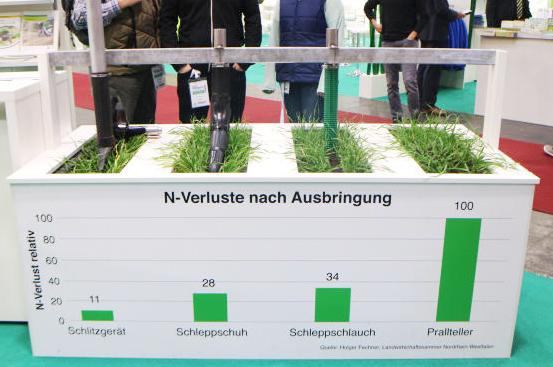Different slurry application methods greatly affect the atmospheric loss of nitrogen and leeching of nitrate into groundwater, according to the Westphalian University of Applied Sciences, Germany. Results of research completed by the university were displayed at Agritechnica last November.
The four most common methods used to apply slurry were compared in terms of the loss of ammonia (NH3) into the atmosphere within the first two hours post spreading. The disc-injector, trailing shoe, dribble bar and splash plate were all compared. The loss of ammonia into the atmosphere was lowest at 11% when a disc injector was used. The reason was the slurry was injected into the ground and absorbed by the roots of the crop, in this case grass. Also, the slurry had the least amount of exposure to air, reducing evaporation. The other advantage of the disc injector was the reduced smells associated with slurry spreading. The next most effective method was the trailing shoe with a 28% loss of ammonia. The dribble bar pipe had a slightly higher amount of ammonia lost within the first two hours at 34%. The researchers said the reason it is so high is there is nothing except crop cover to prevent the loss. The slurry is sitting on the soil and on the plant with contact to the air still very high. The big take-home message, though, was that the splash plate had the potential to lose 100% of ammonia within the first two hours of application.
Different slurry application methods greatly affect the atmospheric loss of nitrogen and leeching of nitrate into groundwater, according to the Westphalian University of Applied Sciences, Germany. Results of research completed by the university were displayed at Agritechnica last November.
The four most common methods used to apply slurry were compared in terms of the loss of ammonia (NH3) into the atmosphere within the first two hours post spreading. The disc-injector, trailing shoe, dribble bar and splash plate were all compared. The loss of ammonia into the atmosphere was lowest at 11% when a disc injector was used. The reason was the slurry was injected into the ground and absorbed by the roots of the crop, in this case grass. Also, the slurry had the least amount of exposure to air, reducing evaporation. The other advantage of the disc injector was the reduced smells associated with slurry spreading. The next most effective method was the trailing shoe with a 28% loss of ammonia. The dribble bar pipe had a slightly higher amount of ammonia lost within the first two hours at 34%. The researchers said the reason it is so high is there is nothing except crop cover to prevent the loss. The slurry is sitting on the soil and on the plant with contact to the air still very high. The big take-home message, though, was that the splash plate had the potential to lose 100% of ammonia within the first two hours of application.






 This is a subscriber-only article
This is a subscriber-only article









SHARING OPTIONS: